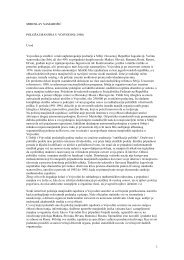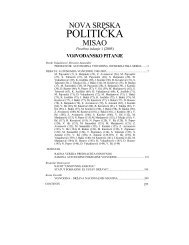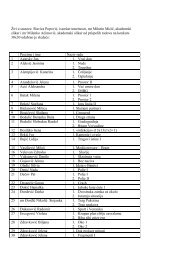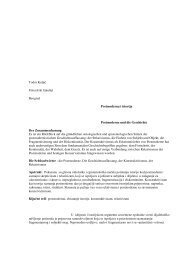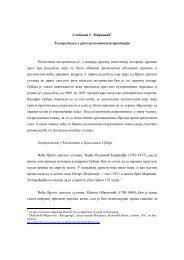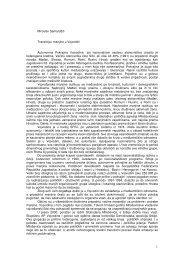Todor Kuljić TITO -sociološkoistorijska studija- (Drugo ... - Početak
Todor Kuljić TITO -sociološkoistorijska studija- (Drugo ... - Početak
Todor Kuljić TITO -sociološkoistorijska studija- (Drugo ... - Početak
You also want an ePaper? Increase the reach of your titles
YUMPU automatically turns print PDFs into web optimized ePapers that Google loves.
summarizes Titos understanding of the party, character of the party purges, the role of the army,<br />
ruling techniques, and finally the patterns of the power justification. It also draws, a distinction<br />
between the stages in which the communist political culture urged modernization from those in<br />
which it started to block modernization.<br />
Tito’s national policy is a variant of modern and democratic idea of Balkans as one indivisible<br />
state entirety. This is a subject matter of Chapter 6. which highlights Titos successful effort and<br />
failures in the attempt of cosmopolitization of the Balkans. This Chapter also discusses the role<br />
of the Yugoslav national idea, outlines the main economic causes of nationalism in the<br />
socialistic Yugoslavia, and summarizes Titos extraordinary active super-national role. This last<br />
element figures as a rather successful and progressive attempt of cosmopolitanization of the<br />
Balkans, exemplary of the leftist spirit of the epoch. The british historian Taylor called Tito<br />
“the last Habsburg” because he ruled a country with eight major ethinic groups, gave them<br />
“cultural autonomy”, and restrained their sesessionist antagonism. Judging by its multiethnic<br />
structure, Tito’s Yugoslavia was, no doubt, most similar to the Austro-Hungarian Empire, but<br />
the integrative ideas (Marxism and Catholicism) were essencially different. Here are discussed<br />
the international and cosmopolitian implications of Marxism in the pacification of an explosive<br />
Balkan space. From the standpoint of long-term historical processes, the Chapter 7. ‘Titos<br />
foreign policy” discusses this policy as a rare example of relatively successful and independent<br />
break through of the hierachical relationship in the international order, and of the unavoidable<br />
hierarchical subordination of small countries to the interests of great powers. Also outlined are<br />
the main stages of Titos foreign policy built on the principles of equidistance, with a special<br />
focus on the threee crisis in the Yugoslav-Soviet relationship, and then the relationship with the<br />
West and the non-alignment policy.<br />
The following 8. Chapter “Structure and Funktion of Titos authority, charisma and cult” gives a<br />
dialectic analysis of the progressive- modernizing, and of the conservative functions of Titos<br />
charisma. His charisma neutralized tensions of an ethnically mixed and explosive region, while<br />
in the sphere of foreign policy Titos personal authority contributed to building up the states<br />
ranking. The party leader and head of state was a symbol of the radical change in the social<br />
structure, i. e. the acceleration of horizontal and vertikal mobility, which is an important aspect<br />
of modernization. The undoubtedly progressive active role of Tito’s charisma in mobilizing the<br />
resistance to fascism and stalinism has already beeen mentioned. Accelerated post-war<br />
development was faciliated by the state’s and Tito’s respectability in the whole world. But here<br />
are not also the conservative sides of Titos cult neglected. Uncritical elevation and admiration<br />
of Tito as a leader of a monopolistic party with no competition caused fast an irrational<br />
relationship of idolatry for an infallible individual and developed an illusion of his role of<br />
savior. The basically rationalistic marxist ideology was the important defense against Tito’s<br />
irrational deification. Here are broader discussed the forms of Tito’s deification and compared<br />
with Stalin’s cult.<br />
Chapter 9. treats the relationship of the Yugoslav intelligentsia towards Tito. Here are<br />
presented the chief patterns of relationship of creative intellectuals towards Tito: (1)<br />
M.Krleža’s glorification of Tito, stemming from the Croatian tradition of the Yugoslav<br />
national idea, (2) demonization of Tito by D.Ćosić and Serbian nationalism,and (3)<br />
differentiated judgment by M.Djilas that sprang from the non-national liberal critics of<br />
Bolshevism. Krleža’s glorification of Tito was deeper than Ćosić,s demonization, and together<br />
with Djilas’s differentiated judgement, it makes an interesting testimony about the relationship<br />
of the relationship of the intellectuals contemporaries, toward Tito.<br />
Chapter 10. “Tito in the new Serbian memory” treats the memory of Tito in historical science,<br />
political ideologies and living oral memory. In the post-communist age historians are busy<br />
with excavating national pasts. The cold memory of Tito is unacceptable in the reconstitution<br />
of a national collective memory. In the context of a new post-communist myth of national<br />
salvation Tito is instrumentalised as a symbol of political evil. In the official memory of the<br />
main former Yugoslav republics he is redundant or unacceptable. But on the other side, in the<br />
Yugo-nostalgic people’s memory and in living oral memory he is still a positive person. After<br />
227



